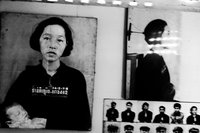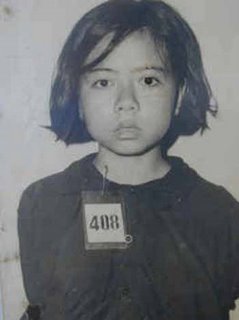
Throughout Susan Sontag's Regarding the Pain of Others, the governing question is how we regard, or rather process, images of atrocity. If her work On Photography was devoted to the image itself, the politics of its reception comes to take precedence in this later work, for those images of atrocity are everywhere: perpetual pictures "speaking" on behalf of those in need of protection from the onslaught or terror, torture, endless war. The human rights theorist Michael Ignatieff claims that ideally those in need of protection can appeal for their rights, but what is the appeal held in the scream, or in the stammering translation of traumatic memory, especially when we only hear it through our seeing, sensing it from afar, and even then, through a regard that finds in the appeal, a beautiful picture?
Tuol Sleng is the infamous prison that was run by the Khmer Rouge of Cambodia. It was a center for the purging of Ankgar, the Organization of its supposed enemies: torture and carefully coerced, then scrupulously documented, confessions, and finally execution. Some 14,000 persons entered, seven survived. Everyone was photographed prior to their abuse and murder. As the anthropologist Lindsay French says of the images that remain, they are deeply disturbing and yet some are absurdly and arrestingly beautiful. They have appeared in galleries, they are for sale, they migrate in an economy of the image. Printed with care, they take on the accusatory and seductive power of an Avedon series; as if he had left the American West and just kept going to the other side of the world, some far side of experience.

How can these images be processed, imaginatively and psychologically? They play a prominent role in Rithay Panh's documentary S21: The Khmer Rouge Killing Machine, a film that brings one prominent survivor, Vann Nath, into "conversation" with several guards from the prison. He sits across from them, piles of photographs and documents on the table. The guards know the crimes they have committed and offer an array of defensive explanations. They remain "victims" and they themselves, they say, cannot "know" or process what happened there, even as they act out the rituals of the prison for Panh's camera. And sitting before the images, or even when forced into a forensic accounting of the murders they are distanced from the horrors; reading the pictures becomes a way of not acknowledging what the pictures show.
When thinking of human rights and their rhetorical necessities, it is hard to calculate the value of witnessing such things. One can stare at the images, one can consider the degradations and the systems of destruction--of human beings, of conscience, of moral injunctions. Even as they suggest some moments about what happened in that country, in that prison, in the aftermath, the images and their originating circumstance seem incredibly, and impossibly, far away. In order to stare, one needs time, and peace, and leaving the space of seeing them there will be a sunlit day, a city nightscape, an afternoon of work in a cafe, sustaining rhythms of safety and contemplation, which always brings with it a certain power and pleasure, no matter the substance of the thought. Of course, the two are always side-by-side, it's just a matter of accepting that fact.
As someone who saw the Tuol Sleng photographs rightly said, the proper absorption of the difficult, dis-heartening, and all the abject cruelties exacts its price. But that price is paid for the knowledge of what the human can do, what Aristotle might remind us to consider in our measure of worldly wisdom, the material that might come into play during the next rhetorical situation, when someone, or someone's image, makes its appeal. Along those lines, Sontag makes the claim that in today's world, no one has the right to be only, safely naive.
Learning to see what is shown and hear the translation of agonies from one dimension to another--often across borders, but more often through historical frames--makes demands. There are so many elements that disrupt our reception, some of them from without, some of them inside ourselves. The old definition of ideology used to be that it forced people to see the world upside down. "People know not what they do." The idea was that if they just learned the truth they would stop being selfish, cruel, heartless, unjust, etc. That definition has since been revised: "People know full well what they do, they just act as if they don't."
This has to do with investment and a willingness to understand--and to be critically engaged with--what one sees and encounters. Reading histories of Cambodia is to be struck by the degree to which those outside Cambodia argued about the truth of what was happening inside the country once it was controlled by the Khmer Rouge. It is true that there were no roaming bands of journalists operating inside the country, and that it took a long time for the realities there to take shape through survivor and refugee testimony. It might be equally true, however, that as Cambodia became a symbol (for a culture divided and at war over Vietnam) that how it was seen, understood, and misunderstood had a great deal to with the investments in seeing, or not seeing, the awfulness that existed there during that time.